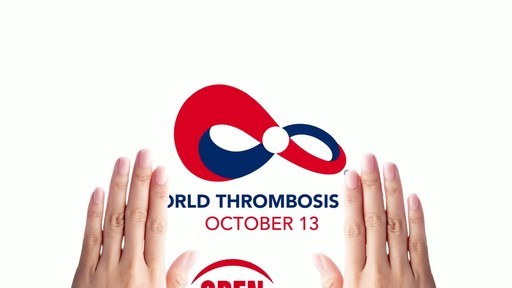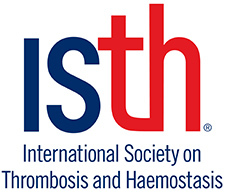World Thrombosis Day Campaign Shines Spotlight on the Life-Threatening Connection Between Thrombosis and COVID-19
In its Seventh Year, the Global Campaign Highlights Importance of a Condition that Contributes to One in Four Deaths Worldwide and Poses a High Risk for COVID-19 Patients
CHAPEL HILL, N.C., Oct. 13, 2020 /PRNewswire/ -- On October 13, the World Thrombosis Day global campaign shares an important message to "Open Your Eyes to Thrombosis and COVID-19."
Blood clots are a known complication among COVID-19 patients, as well as a contributor to a host of life-threatening medical conditions, such as heart attack, stroke and venous thromboembolism (VTE). This additional risk makes it more important than ever to raise awareness of this often-overlooked condition, also known as thrombosis, which contributes to one in four deaths worldwide.
Thrombosis can be prevented, and the first step toward prevention is an awareness of signs and symptoms. The World Thrombosis Day campaign aims to educate patients, caregivers and medical professionals about the early warning signs, the importance of screening upon hospital admission, prompt interventions and the optimal treatments.
This year, World Thrombosis Day draws particular attention to hospital-associated and COVID-19-associated blood clots.
"World Thrombosis Day has consistently placed a global spotlight on hospital-associated blood clots to raise awareness of this common and under-recognized preventable health issue," said Prof. Beverley Hunt, OBE, chair of the World Thrombosis Day Steering Committee. "This year, the global pandemic has only heightened the need for everyone to be proactive about knowing the signs, symptoms, and prevention of blood clots."
Hospitalized patients, such as those people who are immobile after surgery or during a long illness, have a higher risk of thrombosis. World Thrombosis Day calls upon more hospitals to adopt measures to screen for and prevent Venous Thromboembolism (VTE). Patients and their families should also speak with their physicians about preventing blood clots after hospital stays.
In severe cases of COVID-19, doctors have reported that some patients develop "sticky blood" that clots unusually. These clots, called microthrombi, can collect in the lungs and cause life-threatening complications. World Thrombosis Day seeks to educate physicians about the best available anticoagulation measures they can take to prevent clots in critically ill COVID-19 patients.
- To prevent blood clots, stay active and hydrated. Being less active while staying at home could increase one's risk for getting a blood clot. Follow simple steps to reduce the risk, such as getting up to move every 90 minutes and staying hydrated.
- Do not skip medications. Keep taking medicine as prescribed even if diagnosed with COVID-19, and do not skip any doses.
- Know the signs and symptoms. Leg pain and tenderness, redness and swelling, shortness of breath, rapid breathing, chest pain and coughing up blood are associated with blood clots.
- Know what to do if hospitalized. Ask a healthcare professional for a VTE risk assessment, which is a questionnaire that gathers medical information to discern a patient's potential risk for developing blood clots.
To learn more about blood clots, visit the World Thrombosis Day website. World Thrombosis Day is on October 13 each year and is led by the International Society on Thrombosis and Haemostasis (ISTH).
For more information on COVID-19 and thrombosis, please read the ISTH's Clinical Guidance on the Diagnosis, Prevention and Treatment of Venous Thromboembolism in Hospitalized Patients with COVID-19.
About World Thrombosis Day
Launched in 2014 and held annually on 13 October, World Thrombosis Day aims to increase public, healthcare professional and health care systems' awareness of thrombosis and, ultimately, to reduce deaths and disabilities from thromboembolic disease through a greater awareness of its causes, risk factors, signs and symptoms, and evidence-based prevention and treatment. The mission of World Thrombosis Day supports the World Health Assembly's global target of reducing premature deaths by non-communicable disease by 25 percent by 2025, as well as the World Health Organization's Thirteenth General Programme of Work 2019–2023, the Montevideo Roadmap 2018-2030 on NCDs and the Political Declaration of UNGA' Third High-level Meeting on NCDs. Visit www.worldthrombosisday.org for more information and to get involved.
About the ISTH
Founded in 1969, the ISTH is the leading worldwide not-for-profit organization dedicated to advancing the understanding, prevention, diagnosis and treatment of thrombotic and bleeding disorders. ISTH is an international professional membership organization with more than 5,000 clinicians, researchers and educators working together to improve the lives of patients in more than 98 countries around the world. Among its highly regarded activities and initiatives are education and standardization programs, research activities, meetings and congresses, peer-reviewed publications, expert committees and World Thrombosis Day on 13 October. Visit ISTH online at www.isth.org.
SOURCE International Society on Thrombosis and Haemostasis

Related Links
WANT YOUR COMPANY'S NEWS FEATURED ON PRNEWSWIRE.COM?
Newsrooms &
Influencers
Digital Media
Outlets
Journalists
Opted In




Share this article